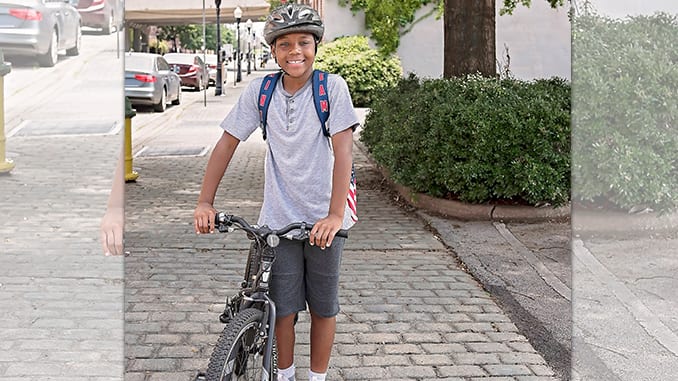
Bike-related accidents send more than 240,000 kids to the emergency room each year. Here’s how to get tots, teens, and in-betweens rolling safely.
Published: July 31, 2018
By: Malia Jacobson
Want to encourage a lifetime of fitness, fun, and freedom? Bicycling offers all three, and today’s young riders are safer than ever. Per government statistics, kids’ fatalities from bike accidents have dropped 62 percent since 1999.
But that doesn’t mean you should turn your kid loose on two wheels without proper preparation. Bike-related accidents still send more than 240,000 kids to the emergency room each year, and 26,000 of those have traumatic brain injuries. Locally, of 144 bike crash victims seen in Children’s of Alabama’s emergency room, at least half weren’t wearing any helmet or protective equipment. Wearing helmets have been proven to significantly decrease head injuries.
Here’s how to get tots, teens, and in-betweens rolling safely.
Early Years 0-5: Balancing Act
Training wheels and trikes aren’t the only options for toddlers who want to ride. These days, more children are hopping on balance bikes – two-wheeled bikes without pedals to get up to speed before graduating to a pedal bicycle. Balance bikes can help kids as young as 18 months build strength and confidence and may get them riding a traditional bike sooner.
You can make your own balance bike by taking the pedals off the bicycle, says Julie Cole Farmer, bike safety educator and Alabama chapter director of ThinkFirst Alabama Injury Prevention Program. “It’s a good way to teach balance, and it’s easy on and off. A big part of how you ride is balance.”
Pick a balance bike based on your child’s height (visit twowheelingtots.com) for sizing guidance; proper fit allows kids to straddle the bike easily and keep both feet solidly on the ground.
Elementary Years 6-12: Ready Set Roll
While some kids are happily riding a two-wheeled bike by first grade, others need more practice and support to feel confident on a bike. If your child is a reluctant rider, don’t give up. Just keep practice sessions fun and brief. And let your child choose a helmet and bike she loves.
Since safety slipups can cause major setbacks for already hesitant kids, take a few minutes to make sure your child’s bike sessions are drama-free. Farmer recommends tying up shoelaces that could get caught in spokes, wearing covered-toe shoes (no riding barefoot or in sandals) and teaching kids to ride single-file, never side-by-side.
“It’s important for kids to know that there is a state law that requires kids wear a bicycle helmet if they are less than 16 years old while riding a bike,” Farmer says. “And parents need to model the right behavior for kids. That means wearing a helmet, too.”
Marie Crew, state chapter director of Safe Kids Alabama, says parents should make sure the helmet fits correctly. “Make a Y around the ears with the straps and make sure the straps touch the chin,” she says. For more information on bike safety and the state law, go to http://www.childrensal.org and search “bike helmet” and “bike law.”
Perhaps the most important thing about bike safety, especially with young children, is parental supervision, Farmer and Crew add. “Until kids are about 10 years old, they can’t really discern where sounds are coming from, and it’s hard for them to determine where traffic is coming from and how fast. If a child is young, stay on the sidewalk.”
Teen Years 13-18: Noggin Nation
Bigger bikers take bigger risks. While kids 10-14 have more bike-related ER visits than older teens, riders 15-19 account for more than half of bike-related deaths. The vast majority (88 percent) of teen bike fatalities are boys. Since your teen probably rides with minimal adult supervision, it’s vital to instill sound helmet habits to keep teens safe, even out of parents’ sight.
Make sure your teen knows the rules for the road for bicycles, Crew says. Bicyclists need to ride in the same direction as traffic and learn hand signals. “Parents need to be active in teaching these rules,” she adds.
Riding after dark or on slick, wet streets increases the risk of crash and injury, so ask teens to call for a ride if they’re out after dark or caught in the rain. Teens are old enough to take some responsibility for maintaining their bike; make regular wheel, frame, drive train and brake checks part of your teen’s regular bike-care routine for years of safe, two-wheeled fun.
Malia Jacobson is a nationally published health and parenting journalist. Lori Pruitt, Birmingham Parent associate editor, contributed to this story.
